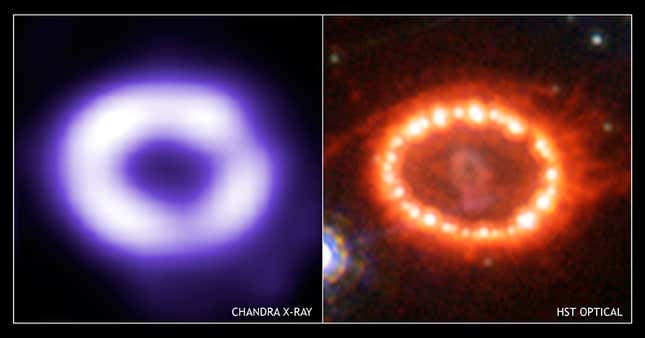The Webb Space Telescope recently imaged Supernova 1987A (SN 1987A), one of the brightest supernovae in the night sky and the nearest observed in centuries, according to NASA.
The image spans 8.5 light years and was taken in September 2022, but was only published today. It is composed of several exposures taken by Webb’s Near-Infrared Camera (NIRCam) and reveals the supernova’s equatorial and outer rings, its crescent, and its inner ejecta (or “keyhole”), the dense core of which not even Webb’s sharp sights can pierce.
Advertisement
The structure’s equatorial ring formed from material that was spewed from the star tens of thousands of years before the supernova occurred, according to a Space Telescope Science Institute release, which took on bright spots as the supernova’s shock wave expanded outward.
SN 1987A sits in the Large Magellanic Cloud, a satellite galaxy of our own Milky Way. The cloud is peppered with regions of star formation, where big clouds of gas collapse to form new stars. But SN 1987A is on the opposite end of the stellar lifetime, as a supernova born from the violent aftermath of a stellar death.
Advertisement
Advertisement

The supernova emits a range of electromagnetic radiation, from long radio waves to short, energetic gamma rays. The Webb observations (as NIRCam’s name suggests) captured near-infrared light from the supernova remnant. Webb’s high resolution revealed crescent structures that are likely outer layers of gas produced by the supernova.
While Webb hasn’t looked at SN 1987A before, it has observed other dusty supernovae. In SN 2004et, Webb saw “the highest dust mass detected in supernovae since SN 1987A,” according to Ori Fox, an STScI project lead who helped produce observations of two supernovae that were published last month.
There are still outstanding questions about SN 1987A, including what happened to the star at the supernova’s center. Whether it’s scrutinizing this supernova or looking elsewhere, future observations by Webb will likely help uncover the truth.
Advertisement
More: Webb Telescope Spots Potential Fuel for Early Universe in Supernovae Debris
Services Marketplace – Listings, Bookings & Reviews